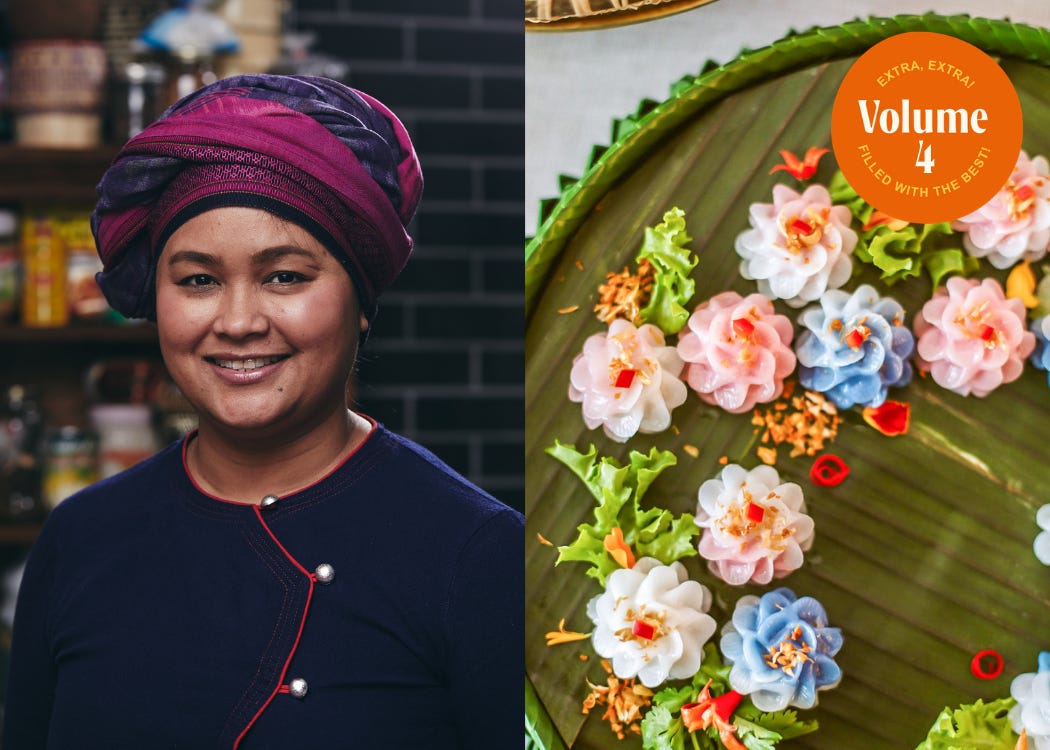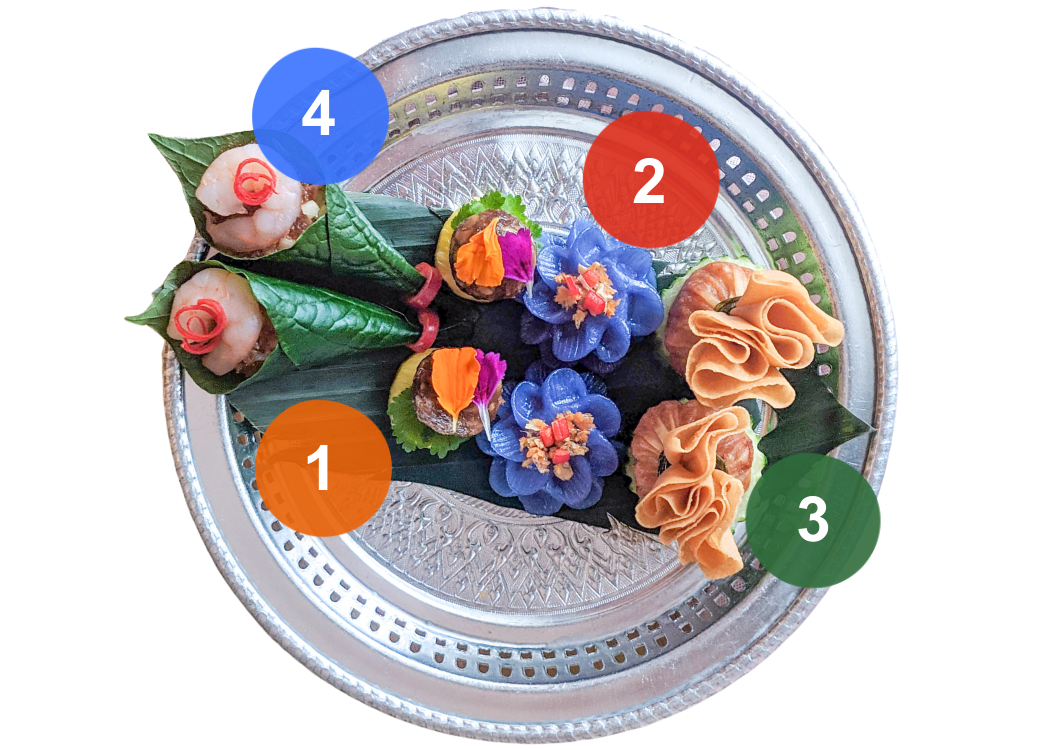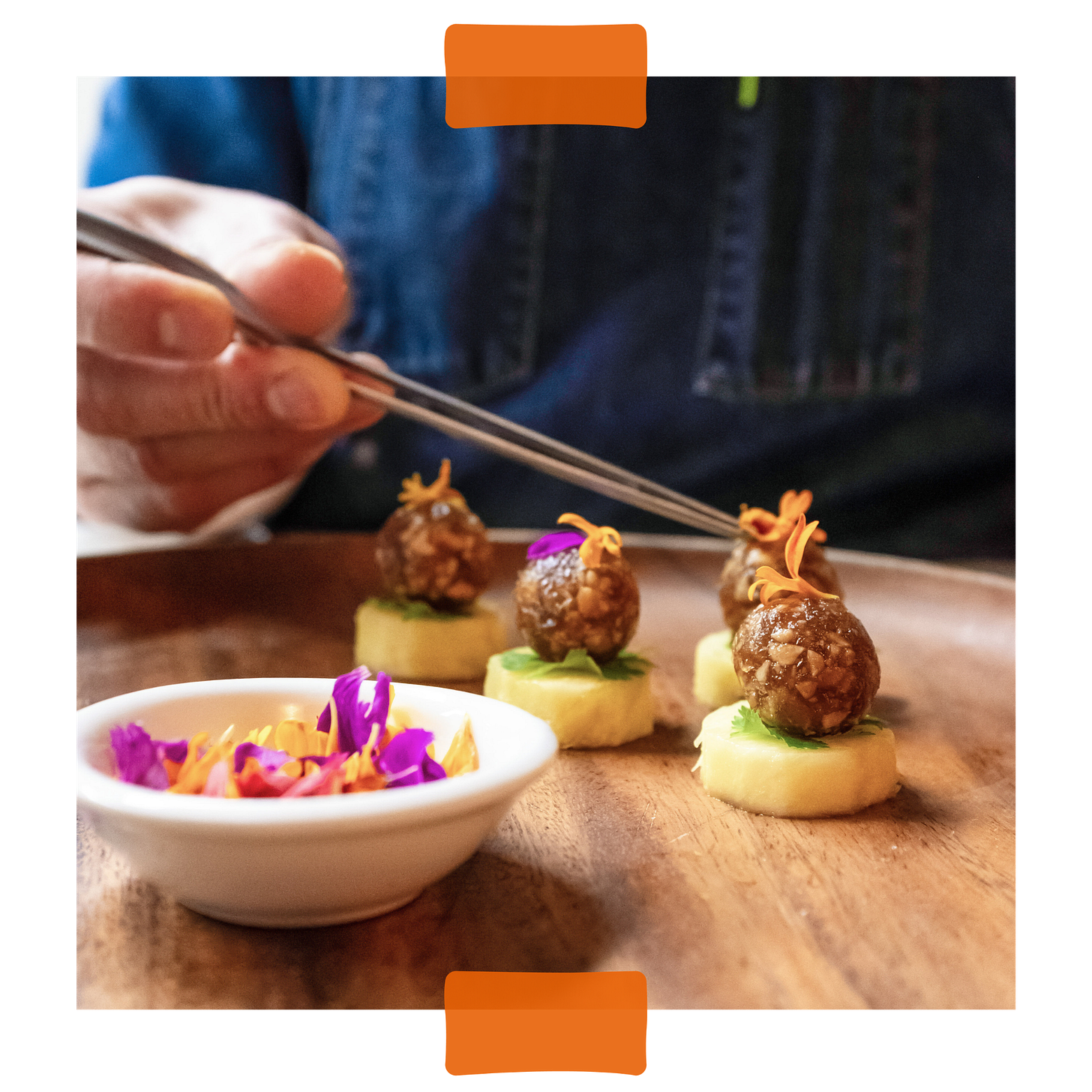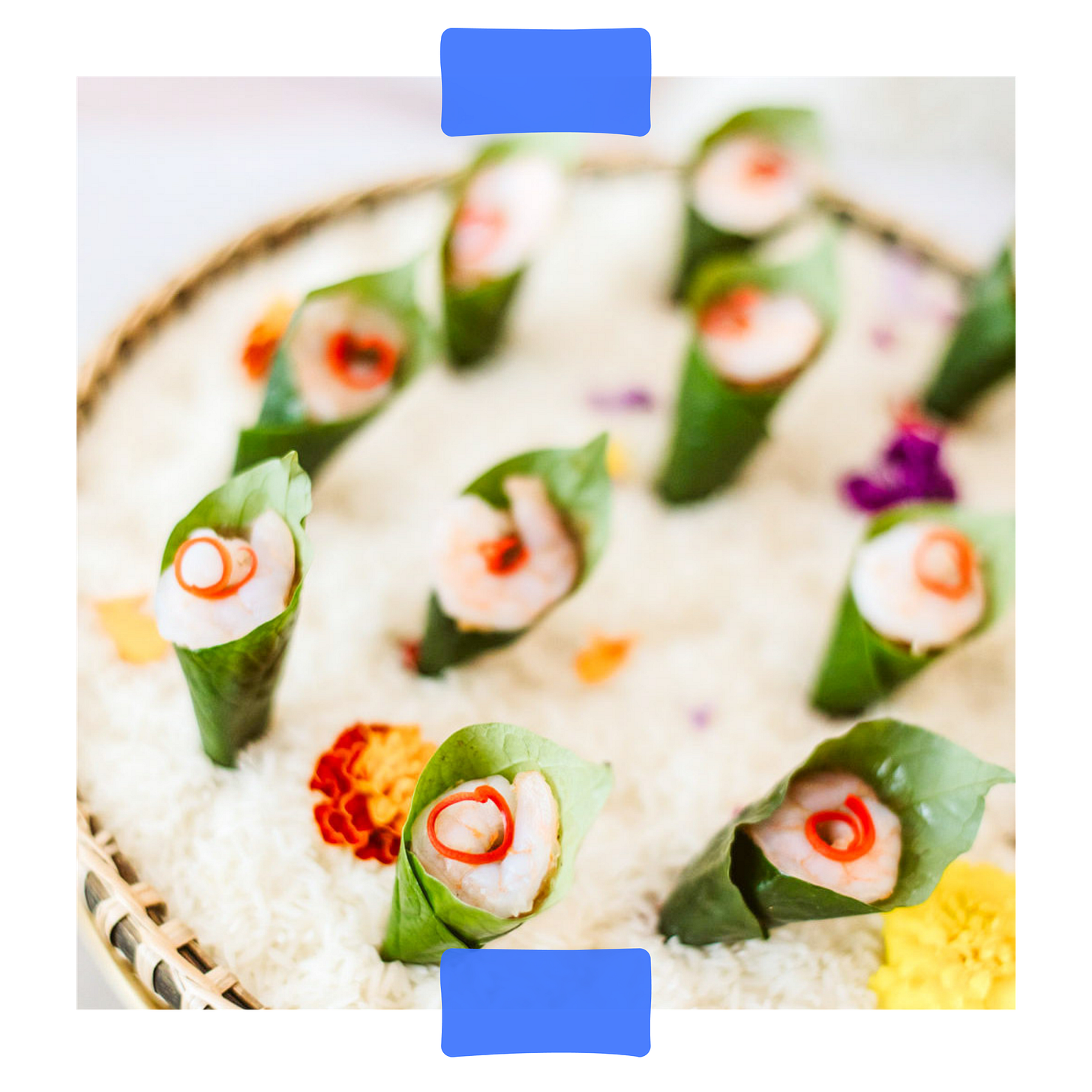Interview #4: Nuit Regular's Roy Thai Platter
“It requires a lot of patience before someone can do one dumpling well. You have a feeling in your heart that you want to do it.”
Dumplings have played a central part in Nuit Regular’s life from a young age: At age 8, growing up in rural northern Thailand, she taught herself how to make the thin, delicate rice flour dumpling called khao kriep pak mor1 after biking to a neighboring village to study a nearby vendor’s work. By 15, she was selling bags of phun sip—crisp, empanada-like pork and peanut dumplings—to her classmates. “It's the feeling of excitement and success at that time,” she says wistfully, thinking back to the sense of satisfaction she derived, even then, from making and sharing one-bite dishes with friends and family. “It requires a lot of patience before someone can do one dumpling well. You have a feeling in your heart that you want to do it.”
Today, Nuit is the chef and co-owner of several high-profile Thai restaurants in Toronto. While most focus on the northern Thai cuisine of Nuit’s background, Kiin, which opened in 2017, focuses on Thai dishes that are lesser known in Canada and incorporates the rigorous culinary traditions of Royal Thai cuisine. It also puts her steadfast love of dumplings on a pedestal by way of the Roy Thai platter, a dish of four intricate, meticulously crafted dumplings. I was lucky enough to try this dish on a work trip to Toronto a couple of years ago and haven’t been able to stop thinking about it since, so the opportunity to nerd out with Nuit about every last detail was an absolute thrill.
Before you dive in, a shameless reminder: Don’t forget to subscribe (it’s free!) and tell…um…everyone you know to do so as well. Thanks so much :)
You operate several Thai restaurants in Toronto. What was the mission behind Kiin specifically?
Most of the restaurants that I opened in Toronto serve Thai street food. I grew up eating street food, so we have street-style Thai restaurants, with dishes like pad Thai and curry—very simple Thai food. When we were planning Kiin, I was thinking about how there is more to Thai cuisine aside from street food, specifically a local cuisine we have called Royal Thai cuisine. At that time, when I searched for Royal Thai cuisine in Canada, there was no one that really showcased it. Growing up as a young kid in a rural area, you heard about Royal Thai cuisine and the very beautiful carvings and very beautiful dumplings. Back then, you couldn’t find any of these dishes on the street. So I read lots of Royal Thai books and kept looking at pictures, and later went back to take some classes at a Royal Thai cuisine school in Thailand. That’s how I learned some of the menu, as well as reading stories about the skills required for producing Royal Thai cuisine. And I fell in love with the cuisine itself.
How would you describe Royal Thai cuisine to someone that’s unfamiliar?
Royal Thai cuisine is a culinary art form that features dishes that were once served to the Royal Thai family. The dishes are really high quality, with lots of elements and intricate detail. It’s a very labor-intensive and time-consuming cuisine, which is why not many Thai people actually cook or serve it—it wouldn’t make sense business-wise, because the quality of the food makes it very expensive and therefore the price point is very high. Thai people, in Thailand, always know how to cook their own food and have fresh ingredients in their backyards, or can buy a very cheap product from the market to cook on their own, so not many Thai people are going to go out to dine and eat expensive food. That’s why the Thai cuisine of the royals in Thailand is actually going extinct.
What was Royal Thai culinary school like?
They told me the history of the dishes, how to cook them, and the techniques they use for cooking. I went to a very intense, advanced class—the teacher was very skilled. I apply the fundamentals of Royal Thai cuisine to my cooking a lot, because it’s very detail-oriented: Whenever I cook, I think about how I can get the best out of the ingredients or do the best version of the dish, whether that’s deciding which vegetable am I going to use, or what will bring out the best of that vegetable.
A signature dish at Kiin is the Roy Thai platter, which showcases Royal Thai dumplings. I’d love to discuss the stories behind the elements of this dish.
There’s so much variety within Royal Thai dumplings, so I started with ones that have distinctive styles.
Mha hor (1) takes the idea of a street food that local people eat at home. Normally during the summer, we have lots of fruits and vegetables, and—especially with sour fruits—Thai people like to eat them with shrimp paste plus sugar, salt, and chili as a snack that exists outside of Royal Thai cuisine. And because chefs planned to serve similar versions of this to the royal table, they make a reduction of coconut sugar that’s very high quality with salt, pepper, and chili and serve it in a one-bite size on top of sour fruit like mango, or sometimes with pineapple. I carve the pineapple itself to be like a flower. Each bite is sour, sweet, salty, and spicy—it’s a very fresh, mouthwatering way to start off the platter.
Chor ladda (2) is a name we made up. In Thailand, this dish is called chor muang, which means “purple flower,” and the color of the dumpling comes from the natural color of butterfly pea flowers that we import from Thailand, boil to make tea, and then mix into rice flour dough. Everyone makes the purple color in Thailand, which comes from squeezing a little drop of lemon or lime into the butterfly pea flower tea, which changes the color from blue to purple. Chor ladda means “flower-like dumplings,” and that’s allowed me to dye the colors of the dough to different colors with the ingredients that I can find locally. Because I live in Canada, they have beautiful colors from beet juice. I will use that to make a light pink, sometimes I use the butterfly pea flower to get blue, and sometimes a little turmeric for yellow. The filling is made with coriander root, onions, pickled radish, coconut, chopped peanuts, and a reduction of coconut sugar. Then we use a tweezer to pull out the dough and make a pattern shaped like a flower. Then you steam them, and eat with a crispy Thai garlic topping and a little bit of chili to represent the center of the flower. It’s a little bit sweet and salty, crunchy from the coconut and peanut, and chewy from the rice flour dough.
Thoong tong (3) is a deep-fried dumpling that has a stuffing of chicken, shrimp, water chestnut, coriander root, garlic, and pepper2. This one is very famous in Thailand, even though it’s Royal Thai cuisine—most people like to cook them at a special festival or gathering because thoong thong means “golden bag,” since its shape looks like a bag of money. It’s wrapped in a spring roll wrapper, and we use chives that we’ve dried a little bit to wrap around the golden bag shape before we deep fry them. This special dumpling you eat with a sweet and spicy sauce. I serve it in a cup of a cucumber to cleanse the palate after eating it.
Min kuhn (4) is a dumpling that looks like a mini hand-roll wrap. It’s a one-bite street food. If you go to Thailand, you will find this skewered in a triangle shape. I didn’t wrap them into a triangle because I wanted to feature the ingredients inside and have some activity during eating. Inside it has shrimp, pomelo, fresh shallots, fresh ginger, fresh red chili, and roasted coconut. Once you eat it, it’s like a party inside the mouth.
Of these four dumplings, is there one that is most challenging to make?
The most challenging to make is the chor ladda. We spend a lot of time training our team to make these flower dumplings, because it requires a lot of skill and practice. You have to do it over and over and over again to get the hang of it. I’ve had to throw out the dough because it’s overcooked just a little bit to where we couldn’t pull out the dough to form the leaves or petals. When you steam them, it has to be a certain kind of steam; when you over-steam them, they’re too hard. And when you serve them, it has to be timed to be eaten immediately after steaming, because it loses its moisture and texture very fast and becomes less tender and soft to bite into.
About how many dumplings a week are you making at Kiin?
Before the pandemic, we were probably making almost 1,600 dumplings a week at the restaurant. We have people trained to do it. Some of them have to make the stuffing because it takes hours. The person that makes the dough has to train to make the dough as well.
You mentioned these four are representative of a broader range of Royal Thai dumplings. If you were to add any additional ones to the platter or swap a new one in, do you have any in mind already?
Yes, I’ve thought about something very cute—it’s a steamed dumpling that looks like a little bird, called khanom jeab nok. It uses a similar skill with the tweezer to make the dumpling look like a white bird, with little sesame seeds as the eyes, and uses red chili to make the mouth. It’s so beautiful. I hope to make it one day in the future.
Last question! When you are making dumplings, do you have any favorite music you like to listen to to get in the zone?
Of course. It’s in Thai. At work, at the restaurant, I have a couple of Thai chefs that work with me so we will turn on the music from our phones and listen to Thai songs and sing along while making them.
Above the Fold was created by Leah Mennies. Logo + design elements by Claudia Mak.
The above interview was condensed and edited. Interview subjects are paid an honorarium for taking the time to share their knowledge and experience—Nuit Regular asked that hers be in the form of a donation to the Asian Mental Health Collective.
Thank you to the wonderful Panicha Imsomboon for sharing culinary wisdom and insights during the research process.
In Nuit’s words: “It’s a very northern Thai, regional dumpling. The name means that it is a dumpling that is made from the top of a pot. It has a rice flour wrapper, and the stuffing is with peanuts, pickled turnips and coriander, garlic, and white pepper. To cook them, we prepare the rice flour-water mix, and steam them using a special steamer with a bottom that’s wider on the bottom than the top. You make one full dumpling at a time by putting the mixture on the steamer, then you let it cook through, then put the stuffing in and wrap it around to make a one-bite dumpling. You can get such beautiful colors with dyes like the butterfly pea flower, or pink, or any color that you want. And the way that it’s wrapped, it’s very thin and light and refreshing. Before you eat it, you just have coconut milk to make it more moist, and the beautiful coconut flavor—wow, my mouth is watering right now (laughs). And you bite it with coriander, lettuce, and some red fresh bird eye chili. So sweet, salty, spicy, and creamy. It’s warm. I used to sell this dumpling in the front of my house, trying to make money for the evening time.”
Nuit’s recipe for thoong tong can be found in Kiin: Recipes and Stories from Northern Thailand, her extremely personal (and beautifully photographed) cookbook that debuted last fall.











Sure, I'm biased because of the name of the dish, but that has got to be one of the most beautiful plates I've ever seen.
Good... Verry good & beauty food... Look nice that taste